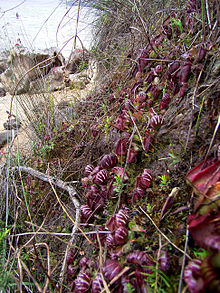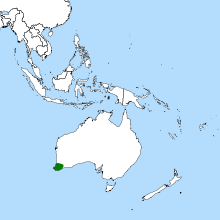Dwarf mug
| Dwarf mug | ||||||||||||
|---|---|---|---|---|---|---|---|---|---|---|---|---|

Dwarf jug ( Cephalotus follicularis ) |
||||||||||||
| Systematics | ||||||||||||
|
||||||||||||
| Scientific name of the family | ||||||||||||
| Cephalotaceae | ||||||||||||
| Dumort. | ||||||||||||
| Scientific name of the genus | ||||||||||||
| Cephalotus | ||||||||||||
| Labill. | ||||||||||||
| Scientific name of the species | ||||||||||||
| Cephalotus follicularis | ||||||||||||
| Labill. |
The dwarf pitcher ( Cephalotus follicularis ), rarely also called the Western Australian pitcher plant, is the only plant species of the dwarf pitcher family (Cephalotaceae) within the order of the wood sorrel (Oxalidales). It occurs only in a small area in the extreme southwest of Australia under moist conditions and is a carnivorous plant . Similar to the not closely related pitcher plants , it catches its prey with pit traps .
description
Habitus
The dwarf jug is an evergreen, perennial, herbaceous plant that grows in down-to-earth rosettes with a height of up to 10 centimeters.
The rhizome is thick, gnarled, covered with numerous scaly leaves and has many branches. It forms new rosettes at its foothills , so that large clumps emerge with age . Numerous fibrous roots form from the rhizome , young plants still have a taproot , which, however, soon dies.
leaves
The dwarf jug forms two types of leaves in the seasonal change : simple flat leaves and heavily modified trap leaves. Occasionally there are also intermediate forms with only half-formed traps that lack the front part. All leaves grow alternately, are petiolate and have single-celled, fine hairs and numerous sessile nectar glands .
The flat leaves are spatula to inverted egg-shaped, tapering to a point and up to 15 centimeters long. The petiole accounts for around half of the leaf length . They are thick and leathery, and the edges are ciliate, the surface is smooth and shiny.
Fall Leaves
The trap leaves are up to 5 centimeters long, egg-shaped, liquid-filled and open-top pitfall traps. They lie on the surface at an angle of 45 ° or are sunk into it in the case of mossy surfaces. The petiole is cylindrical and fused with the back of the upper edge of the trap.
Four very hairy bars on the outside of the traps make it easier for crawling animals to reach the trap opening. The outer skin is completely covered with glands that secrete a liquid, presumably nectar .
A lid over the opening, an outgrowth of the petiole, spans the inside and protects it from rain, which could overflow the can liquid and wash out dead prey. It is curved, notched and ciliate on the edge, a central rib is missing. The inside is covered with short, downward-facing hair. The lid is alternately divided into white, translucent and dark red, chlorophyll-free sections. The translucent areas look like a window, trapped flying insects try to escape through here, only to then plunge back into the cans.
The edge of the trap, which overhangs inwards, is thickened and covered with large, inward-pointing, claw-like teeth, with nectar glands between them. Immediately thereafter, an area of short, downwardly directed papillae begins, which make it difficult to climb back. The remaining inner wall of the cauldron is smooth, so that the prey slips into the trap and can no longer climb out of it.
The upper third, or the upper half of the trap leaf, is finely covered with glands. In the lower part of the trap there are two kidney-shaped, red-colored spots that are densely covered with larger glands. These glands most likely make up the fluid in the jug, as well as the digestive enzymes, and also take in the nutrients from the prey.
Flowers, fruit and seeds
Stipules are missing. The single standing flower stalk appears at the beginning of Australian summer (flowering time: January – February) and is up to 60 centimeters long, at its end there is a panicle . Each of the minor axes bears up to four or five white, upright, six-fold flowers with a diameter of up to 7 millimeters. Petals are missing and the six carpels are not fused. When the flowers are fertilized, they lower. The piston-shaped, leathery, hairy fruits are follicles and contain one or two brown, egg-shaped seeds with a membranous testa and a rich, granular endosperm . The seeds are 0.8 millimeters long and 0.4 millimeters wide, germination only occurs if the seed remains in the fruit.
Cytology and Ingredients
The number of chromosomes is 2n = 20. Tannin cells are also present, as are myricetin , quercetin , ellagic acid and gallic acid , and there are no iridoids .
ecology
The flowers are pollinated by small insects, more precise information is not available. Occasional bushfires survive the plants underground by sprouting again from the rhizome; however, the seeds are not fire germs.
Carnivory
After the jar has been formed, the lid lifts off the peristome and the jar is ready to be caught. Digestive fluid is already in the jug. The prey animals are attracted by nectar deposits on the underside of the jar lid and between the grooves of the jar rim, fall into it and drown. The liquid contains enzymes that break down the nutrients, including esterases , phosphatases, and proteases . In the majority of cases, ants are caught.
Traps as biotopes
As with all other carnivorous plant species with sliding traps, the trap liquid is also a biotope for other living beings. A study published in 1985 counted 166 different species, including 82% protozoa , 4% little-bristle and nematodes , 4% arthropods ( copepods , bipeds and mites ), 2% rotifers , 1% tardigrade and 7% others (bacteria, fungi, algae). Bacteria and fungi in particular also secrete digestive enzymes and thus support the digestive process of the plant. It is particularly noticeable that the traps are the "nursery" of two two-winged species. In addition to the larvae of a Dasyhelea species, the larvae of the stilt fly Badisis ambulans also live in the cans.
Spread and endangerment

The plant is endemic in the Australian southwest, in the coastal areas northeast of Albany in a zone of around 400 kilometers between Augusta and Cape Riche . The dwarf jug is common within its area. It is mainly found in peat moss cushions on consistently moist, but well-drained, acidic peat soils over granite, in seepage water areas, along river banks or under so-called tussock , clump -like grasses (e.g. from Restionaceae ).
The dwarf jug is due to its limited distribution area by the IUCN as "Endangered" ( Vulnerable classified). However, there is no acute risk. Since parts of its range are protected and the plants are common within their range, they have been deleted from CITES Appendix II.
Systematics
Both the genus and the family dwarf pitcher plants (Cephalotaceae) contain only one species and are therefore monotypic or monogeneric . The closest relatives are the Cunoniaceae .
Besides Brocchinia reducta the dwarf jug is the only carnivorous plant, not to the orders of the Lippenblütlerartigen , caryophyllales or heather-like part and therefore not even indirectly with other carnivorous is related plant species.
Botanical history
The dwarf jug may have been discovered by the botanist Archibald Menzies as early as 1791 during an expedition . In 1806 the plant was first described by Jacques Julien Houtton de La Billardière . As early as 1800 Robert Brown had observed the trapping of insects in this species. From 1823 the plants were cultivated in the Kew Gardens Botanical Gardens . In 1829 Dumortier placed the species in its own family, which is still monotypical today.
Due to the shape of the dust bag , La Billardière used the Greek term kefalotus ("having a head") for the generic name. Follicularis comes from follicus , which means " little bag" and refers to the shape of the jars. The dwarf pitcher is called the Albany Pitcher Plant or the Western Australian Pitcher Plant .
use
The dwarf jug is popular among lovers of carnivorous plants and is cultivated worldwide - but keeping it is considered demanding.
proof
Footnotes directly behind a statement cover the individual statement, footnotes directly behind a punctuation mark the entire preceding sentence. Footnotes after a space refer to the entire preceding text.
- ↑ a b c d e f g h Wilhelm Barthlott , Stefan Porembski, Rüdiger Seine, Inge Theisen: Karnivoren. Biology and culture of carnivorous plants. Ulmer, Stuttgart 2004, ISBN 3-8001-4144-2 , pp. 87-90.
- ↑ a b c d e f g h i j John G. Conran: Cephalotaceae. In: Klaus Kubitzki : (Ed.): The Families and Genera of Vascular Plants. Volume 6: Flowering Plants - Dicotyledons - Celastrales, Oxalidales, Rosales, Cornales, Ericales. Springer, Berlin et al. 2004, ISBN 3-540-06512-1 , pp. 65-69.
- ^ A b c d Allen Lowrie : Carnivorous Plants of Australia. Volume 3. University of Western Australia Press, Nedlands 1998, ISBN 1-875560-59-9 , pp. 128-131.
- ^ A b Francis Ernest Lloyd: The Carnivorous Plants (= A New Series of Plant Science Books. 9, ZDB -ID 415601-8 ). Chronica Botanica Company, Waltham MA 1942, pp. 81-89, (Reprinted: Dover, New York NY 1976, ISBN 0-486-23321-9 ).
- ^ David Yeates: Immature stages of the apterous fly Badisis ambulans McAlpine (Diptera: Micropezidae). In: Journal of Natural History. Vol. 26, No. 2, 1992, ISSN 0022-2933 , pp. 417-424, doi : 10.1080 / 00222939200770241 .
- ↑ Cephalotus follicularis in the endangered Red List species the IUCN 2007. Posted by: Conran, JG, Lowrie, A. & Leach, G., 2000. Accessed 11 May 2008 ..
- ^ Peter D'Amato: The savage garden. Cultivating carnivorous plants. Ten Speed Press, Berkeley CA 1998, ISBN 0-89815-915-6 .
- ^ Jean-Jacques Labat: Carnivorous Plants. Select and maintain. Ulmer, Stuttgart 2003, ISBN 3-8001-3582-5 .



